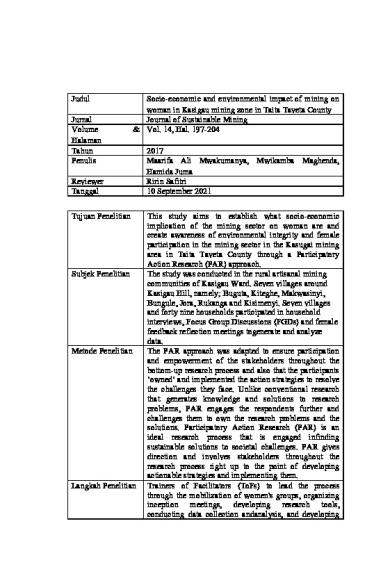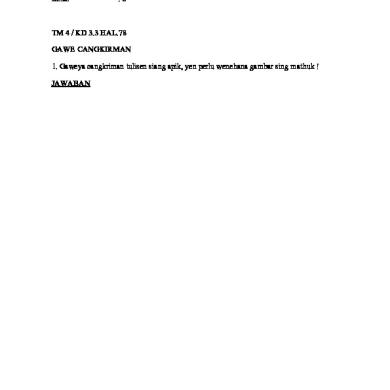* The preview only shows a few pages of manuals at random. You can get the complete content by filling out the form below.
Description
Judul Jurnal Volume Halaman Tahun Penulis
Socio-economic and environmental impact of mining on woman in Kasigau mining zone in Taita Taveta County Journal of Sustainable Mining & Vol. 14, Hal. 197-204
Reviewer Tanggal Tujuan Penelitian
Subjek Penelitian
Metode Penelitian
Langkah Penelitian
2017 Maarifa Ali Mwakumanya, Mwikamba Maghenda, Hamida Juma Ririn Safitri 10 September 2021 This study aims to establish what socio-economic implication of the mining sector on woman are and create awareness of environmental integrity and female participation in the mining sector in the Kasugai mining area in Taita Taveta County through a Participatory Action Research (PAR) approach. The study was conducted in the rural artisanal mining communities of Kasigau Ward. Seven villages around Kasigau Hill, namely; Buguta, Kiteghe, Makwasinyi, Bungule, Jora, Rukanga and Kisimenyi. Seven villages and forty nine households participated in household interviews, Focus Group Discussions (FGDs) and female feedback reflection meetings togenerate and analyze data. The PAR approach was adapted to ensure participation and empowerment of the stakeholders throughout the bottom-up research process and also that the participants ‘owned’ and implemented the action strategies to resolve the challenges they face. Unlike conventional research that generates knowledge and solutions to research problems, PAR engages the respondents further and challenges them to own the research problems and the solutions. Participatory Action Research (PAR) is an ideal research process that is engaged infinding sustainable solutions to societal challenges. PAR gives direction and involves stakeholders throughout the research process right up to the point of developing actionable strategies and implementing them. Trainers of Facilitators (ToFs) to lead the process through the mobilization of women's groups, organizing inception meetings, developing research tools, conducting data collection andanalysis, and developing
Hasil Penelitian
action strategies. The ToFs trained and engaged women from all the groups in the research process. 1. Women in mining in Kasigau The Kasigau ward consists of small scale mining communities which are employed in mining activities, as workers and as miners. Itwas observed that women had been engaged in the mining sector mostly as casual workers in the mining processes and mineral dealers with no legal mining rights (Zururas) and as marketing agents or brokers. These engagements have exposed women to different socio-economic and environmental impacts. However, they face challenges as they can be conned and cheated of the value of the minerals due to their lack of basic gemological knowledge and skills. Female casual labourers who constitute about 19% of the household women in Kasugai work long hours in the mines with meager payments, which is not a fair reflection of their efforts and the value of the minerals extracted. The operational environment for casual labourers is also not conducive for women as they are located in the wilderness with harsh mining conditions affecting their safety and health. Women work in deplorable conditions with limited water for drinking or bathing; this, in turn, discourages women from engaging in mining 2. The socio-ekonomi status of women in Kasigau The sources of livelihood for the Kasigau community are comprised of small scale agricultural activities, trade and artisanal and small scale mining. About 45% of women in Kasigau take part in subsistence farming as their single main economic activity. Farming and livestock,and farming and artisanal mining each represent 20% of thewomen, while small scale business and farming attracts only 9% ofthe women. Basket weaving and small scale business enterprisesare taken up by only 4% of the women and only 2% of the womensolely engage in small scale business enterprises in Kasigau. Mining activities areincreasingly becoming an economic activity that women take partin, although typically concurrently with other sources of income,probably due to the unpredictably low income from artisanal mining in the area. Althoung doing plant, the mowan here also working in mining with combine those activity. 3. Ownership of land and mining sites According to the PAR findings, about 73% of women do not own land in Kasigau due to the oppressive and
parochial cultural practices. This is one reason why women are not economically empowered as they lack the means of production. Culturally it can be observed that woman do not participate in decision-making matters. Owning land empowers the woman to use it independently, a decision that should be made by a man in such a discriminative socio-cultural setup. Consequently 78% of the households' women in Kasigau do not own mining sites. This is probably due to the cultural practices and the fact that mining activities are not one of the core activities of women. The mining sites in Kasigau are located in the wilderness in ranches and national parks, which are often inaccessible by roads except by feeder pathways. It is difficult for women to walk long distance in the wilderness as it exposes them to the dangers of wild animal attacks. The infrastructure and facilities in the mines are extremely poor. There is inadequate basic equipment and tools to enable women to work effectively and they lack basic occupational health and safety facilities, exposing woman to pollution and other environmental hazards. There is no personal protective gear in the artisanal mines and a lack of adequate life savers and first aid kits exposes women to physical injuries and psychological stress. Female miners have no basic training on occupational health and safety issues, thus they are unable to protect themselves in the event of the occurrence of a hazard. The mining activities have contributed immensely to environmental degradation due to the clearance of vegetation to establish mining sites. 4. Level of compliance with regulations and standards It can be observed that mine workers lack basic personal protective facilities such as helmets, gloves and hearing protection. The mining tunnels are not adequately reinforced and could collapse at any moment while the mining site has an abundance of open pits and tailings which exposes the female workers to occupational health and safety hazards. The environmental regulations and standards are clear concerning the ideal conditions of mining sites to ensure the health and safety of the workers and the integrity of the environment of such sites. However, the county and national standards and guidelines are not adequately observed in mining sites, especially in those that are located in places that are inaccessible to enforcement agencies. 5. Challenges in the mining sector in Kasigau
The challenges are enormous and they need empowered and united communities of women to tackle them. Stakeholders should come to the rescue of women through educating, sensitizing and encouraging women to participating in high value end activities. However, women believe that there are collective strategies that will help them overcome the challenges 6. Actionable Strategies to empower woman The PAR process generated actionable strategies that empower women to tackle the challenges and productively engage in the mining sector. Women have the potential to reap benefits from the mining sector when they are adequately empowered and facilitated. Education, training and awareness are critical elements of the empowerment that women need in order to galvanize themselves to support and facilitate each other. It is evident that woman in Kasigau are vulnerable to social, economic and environmental injustices and that they understand the challenges and have realized the need to take action to improve their health, safety and social wellbeing. Kekuatan Penelitian
Kelemahan Penelitian Kesimpulan
The strength of this research is that the researcher conducts research directly in the field and conducts interviews with the right sources, namely directly to women in the area. So that much can be obtained and can be known from the solutions to the problems that occur. The weakness of this research is that there are too many result and discussions and those that are discussed are long enough to make the reader bored. Most women are involved in mining as “Zururas” with no formal training, equipment or licenses to undertake mining activities because of low income and high levels of poverty. This scenario is similar to many other mining areas in Taita Taveta County, as stated by women from outside the Kasigau mining areas. Women in Kasigau need support and facilitation, to enhance their potential, through education and training, awareness and advocacy on land ownership issues, mining rights, mineral and value addition, and environmental sustainability. This will in turn lead to effective engagement in the artisanal mining sector. It should be noted that organized women's groups can create networks within these groups and with other groups from outside Kasigau, which can lead to
advocacy, campaigning and lobbying for female empowerment in the artisanal mining sector. The PAR process has enabled women to internalize the challenges in the artisanal mining sector and has enabled them to devise strategies to change the situation through socioeconomic, legal and environmental empowerment.













